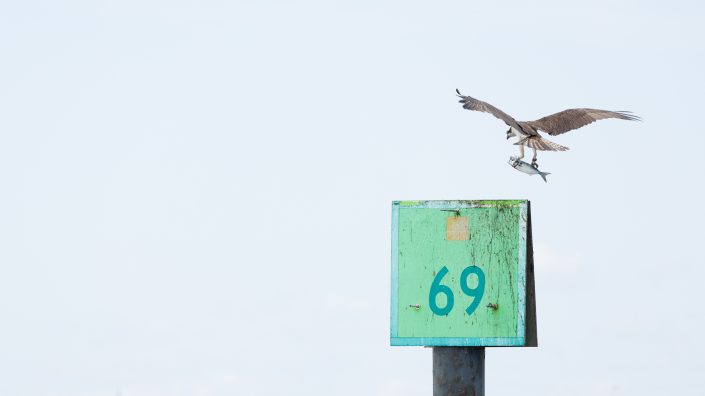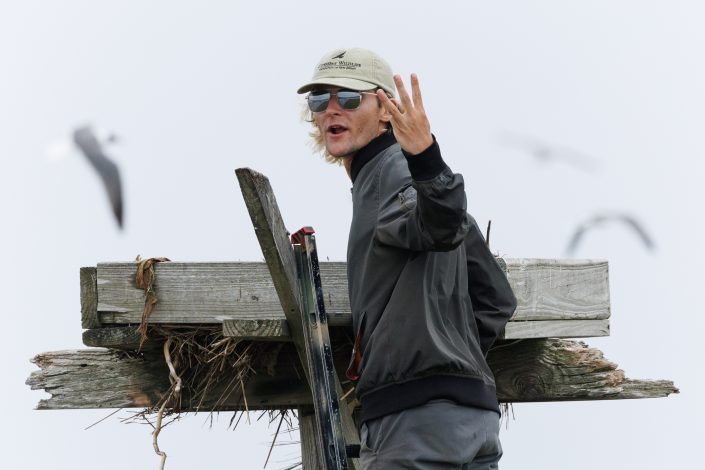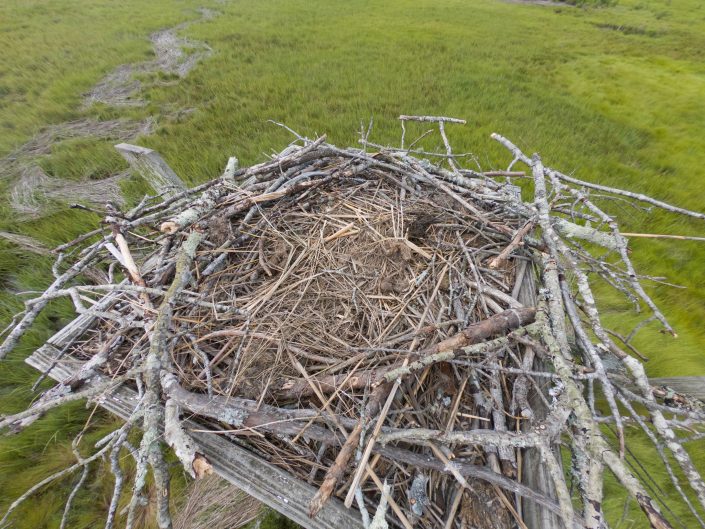Brood Reduction: New Jersey Osprey Cams Shine Light on Prey Availability
by Ben Wurst, Senior Wildlife Biologist






Depending on where you look and who you talk to, the fate of many osprey nests might bring tears to your eyes. Since a nor’easter impacted the coast with strong onshore winds for several days, young ospreys have been dying of starvation in plain sight. Over the past week, several reports of adults who abandoned their nests with young have been received. This year, weather has impacted the availability of fish and outcomes of nests in the Garden State.
Viewers of osprey cams throughout New Jersey have witnessed the effects of brood reduction, which is observed in many species of birds throughout the world. It is where the number of young produced are reduced through the lack of natural resources (food, specifically fish for ospreys). While we haven’t seen widespread brood reduction here for the past couple decades, it has always been creeping in the shadows.
| Pete McLain Osprey Cam | No brood reduction (Produced two young (one egg did not hatch)). |
| Barnegat Light Osprey Cam | Lost two of three nestlings (2-2.5 wks old) in mid-June. |
| Friends of Forsythe NWR Osprey Cam | Lost two of four nestlings (~4 wks old) in mid-June |
| Ocean City Osprey Cam | Lost two nestlings in early July (~5 wks old). Nest attempt failed. |
| Wetlands Institute Osprey Cam | Lost two nestlings in early July (~5 wks old). Nest attempt failed. |
| Cape May Meadows Osprey Cam | Lost all three hatchlings in mid-June. Nest attempt failed. |
Brood reduction is actually quite common in ospreys, as they are specially adapted for it. Females lay 2-3 eggs and incubate asynchronously, which means that they start incubating after the first egg is laid. The first egg always hatches first. This in turn gives that hatchling an advantage in age and dominance over its siblings for food, especially when it is not as plentiful. Broods of only one nestling have experienced brood reduction.
However, we have not witness such widespread brood reduction in ospreys over the past two decades. This year it was observed at almost every osprey cam nest in New Jersey. It first occurred after a nor’easter hit the area in mid-June. The storm, with strong onshore winds impacted the area for several days, made it very difficult for ospreys to find prey, which then caused many nests, including several osprey cam pairs, to lose nestlings that were a few days old to around 2.5-4 weeks old. A month later, it seems that the local abundance of Atlantic menhaden, a forage fish which has been a staple for ospreys here and elsewhere along the Atlantic coast, has been effected. Menhaden abundance has been a crucial link in the overall recovery of ospreys in New Jersey, as it is a primary food source during the nestling period from late May through July.

It has gotten worse with late season nest failures where young continue to die from starvation. During traditional nest surveys, staff and volunteers typically visit nests once a season to determine outcome. Though, this does not always document the true outcome. When nest surveys are done early and prey is limited late in the season (like this year), then some young may not survive to fledge and if repeat surveys aren’t conducted then we don’t know the true outcome — osprey cams have given us a view of how widespread brood reduction is.
Last week I heard of a nest in Bayville, which had two three week old when we surveyed it a week earlier, where local residents found a dead nestling on the ground and no adults present. The remaining nestling was collected by a wildlife rehabilitator and it was successfully fostered into another nest during a nest survey (more on this below). Yesterday morning, the remaining nestling at the Ocean City Osprey Cam fell from the nest after not being attended to for the entire weekend, and I also got several other emails/phone calls/messages from concerned residents about nests with adults who have young and have gone missing. It seems to be getting worse within colonies throughout southern coastal New Jersey.
While we aren’t always certain of the direct cause of a nest failure, osprey cams provide that evidence and we believe that prey availability has played a leading role. When a male can’t find prey (they normally do the majority of foraging) then the female is forced to forage for herself and her young. That means that no adults are on the nest to protect their young. This allows intruder (young non-breeding adult) ospreys to come in and usurp the breeding pair. If they did manage to return with prey to feed their nestlings, then they may be forced to battle over their nest while their remaining young starve — very difficult to watch.

Data from our surveys of nests on Barnegat Bay show that ospreys did not fare terribly after the nor’easter in June; however, we saw many more failed nests (ones with no young) further to the south (LEH and Mullica River). We’re planning to wrap up our surveys this week and conduct some follow up surveys to determine the true outcome of osprey nests throughout our survey area. We have encouraged our volunteers to re-check nests and if you watch a nest, please keep an eye out for missing adults and starving young.
On the topic of intervening, our policy has always been to only act when the impact to the individual bird or nest was caused by humans, like if a bird gets entangled in plastic marine debris. With that said, as emotional beings we have still tried to do everything we can to help ospreys (and other birds) in need, like fostering young from one nest into another, as it is shown to work. Though, what is unfolding this year is extraordinary. We do not have the resources or capacity to intervene and deliver food to every osprey nest that has young who are starving. Even if we did decide to take young who were starving and place them into other nests, then we would be shifting that burden onto other ospreys who might also be having a difficult time to raise their young. If those fostered or artificially fed young survive to fledge, then what happens when they try to seek out fish to feed themselves? If adults can’t find food to support their brood of young, then fledglings won’t have many foraging opportunities for themselves.

Finally, ospreys have done quite well in New Jersey over the past couple decades, so the recent nest failures should not affect their long term stability. It is only problematic if this trend continues, like the situation on the Chesapeake Bay, where many nests are failing and not meeting thresholds to sustain the population. The limited availability of menhaden is to blame. Ospreys are indicating that something is wrong in the environment. The climate is changing and we should all be concerned for the future of our planet and its inhabitants.
>> Learn more about our work with ospreys
>> Watch the live streaming Barnegat Light Osprey Cam
Discover more from Conserve Wildlife Foundation of NJ
Subscribe to get the latest posts sent to your email.
Leave a Comment
Thanks Ben for a very well written and informative article. It is great to have you watching over New Jersey osprey. Jim
Hi I have been watching the ibsp webcam There were two hatchlings they seemed to be avoiding one of the babies. Now they are fledglings and I only see one . Do you ever get involved to help if you notice a bird is not being fed.
Hi Joyce, I have seen only one fledgling there as well. Once young ospreys fledge or leave the protection of their nest, anything could happen to them. Juveniles have very high mortality rates as well. It is hard to determine what happened to the other fledgling, unless someone would find the bird or re-sight by the red aux. band, which is how we can learn more about them after they fledge. Otherwise, we do not get involved with supplementing food at nests.
Comments are closed.